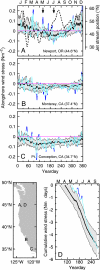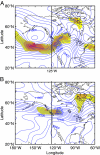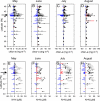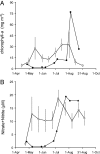Delayed upwelling alters nearshore coastal ocean ecosystems in the northern California current
- PMID: 17360419
- PMCID: PMC1805484
- DOI: 10.1073/pnas.0700462104
Delayed upwelling alters nearshore coastal ocean ecosystems in the northern California current
Abstract
Wind-driven coastal ocean upwelling supplies nutrients to the euphotic zone near the coast. Nutrients fuel the growth of phytoplankton, the base of a very productive coastal marine ecosystem [Pauly D, Christensen V (1995) Nature 374:255-257]. Because nutrient supply and phytoplankton biomass in shelf waters are highly sensitive to variation in upwelling-driven circulation, shifts in the timing and strength of upwelling may alter basic nutrient and carbon fluxes through marine food webs. We show how a 1-month delay in the 2005 spring transition to upwelling-favorable wind stress in the northern California Current Large Marine Ecosystem resulted in numerous anomalies: warm water, low nutrient levels, low primary productivity, and an unprecedented low recruitment of rocky intertidal organisms. The delay was associated with 20- to 40-day wind oscillations accompanying a southward shift of the jet stream. Early in the upwelling season (May-July) off Oregon, the cumulative upwelling-favorable wind stress was the lowest in 20 years, nearshore surface waters averaged 2 degrees C warmer than normal, surf-zone chlorophyll-a and nutrients were 50% and 30% less than normal, respectively, and densities of recruits of mussels and barnacles were reduced by 83% and 66%, respectively. Delayed early-season upwelling and stronger late-season upwelling are consistent with predictions of the influence of global warming on coastal upwelling regions.
Conflict of interest statement
The authors declare no conflict of interest.
Figures






Similar articles
-
Optimal Environmental Conditions and Anomalous Ecosystem Responses: Constraining Bottom-up Controls of Phytoplankton Biomass in the California Current System.Sci Rep. 2016 Jun 9;6:27612. doi: 10.1038/srep27612. Sci Rep. 2016. PMID: 27278260 Free PMC article.
-
Intensification and spatial homogenization of coastal upwelling under climate change.Nature. 2015 Feb 19;518(7539):390-4. doi: 10.1038/nature14235. Nature. 2015. PMID: 25693571
-
Biogeography of ocean acidification: Differential field performance of transplanted mussels to upwelling-driven variation in carbonate chemistry.PLoS One. 2020 Jul 17;15(7):e0234075. doi: 10.1371/journal.pone.0234075. eCollection 2020. PLoS One. 2020. PMID: 32678823 Free PMC article.
-
Upwelling Bays: How Coastal Upwelling Controls Circulation, Habitat, and Productivity in Bays.Ann Rev Mar Sci. 2020 Jan 3;12:415-447. doi: 10.1146/annurev-marine-010419-011020. Epub 2019 Sep 17. Ann Rev Mar Sci. 2020. PMID: 31530079 Review.
-
Recruitment dynamics in complex life cycles.Science. 1988 Sep 16;241(4872):1460-6. doi: 10.1126/science.11538249. Science. 1988. PMID: 11538249 Review.
Cited by
-
Nuclear microsatellites reveal population genetic structuring and fine-scale pattern of hybridization in the Japanese mantis shrimp Oratosquilla oratoria.PeerJ. 2020 Nov 5;8:e10270. doi: 10.7717/peerj.10270. eCollection 2020. PeerJ. 2020. PMID: 33194430 Free PMC article.
-
Widespread and increasing near-bottom hypoxia in the coastal ocean off the United States Pacific Northwest.Sci Rep. 2024 Feb 15;14(1):3798. doi: 10.1038/s41598-024-54476-0. Sci Rep. 2024. PMID: 38361014 Free PMC article.
-
Jet stream intraseasonal oscillations drive dominant ecosystem variations in Oregon's summertime coastal upwelling system.Proc Natl Acad Sci U S A. 2007 Aug 14;104(33):13262-7. doi: 10.1073/pnas.0700926104. Epub 2007 Aug 8. Proc Natl Acad Sci U S A. 2007. PMID: 17686987 Free PMC article.
-
Increasing instability of a rocky intertidal meta-ecosystem.Proc Natl Acad Sci U S A. 2022 Jan 18;119(3):e2114257119. doi: 10.1073/pnas.2114257119. Proc Natl Acad Sci U S A. 2022. PMID: 35012984 Free PMC article.
-
The effects of temperature and pH on the reproductive ecology of sand dollars and sea urchins: Impacts on sperm swimming and fertilization.PLoS One. 2022 Dec 1;17(12):e0276134. doi: 10.1371/journal.pone.0276134. eCollection 2022. PLoS One. 2022. PMID: 36454769 Free PMC article.
References
-
- Pauly D, Christensen V. Nature. 1995;374:255–257.
-
- Wooster WS, Reid JL. In: The Sea. Hill MN, editor. Vol 2. New York: Wiley; 1963. pp. 253–280.
-
- Huyer A, Sobey EJC, Smith RL. J Geophys Res. 1979;84:6995–7011.
-
- Menge BA, Daley BA, Lubchenco J, Sanford E, Dahlhoff E, Halpin PM, Hudson G, Burnaford J. Ecol Monogr. 1999;69:297–330.
-
- Bakun A. Science. 1990;247:198–201. - PubMed
Publication types
MeSH terms
Substances
LinkOut - more resources
Full Text Sources

